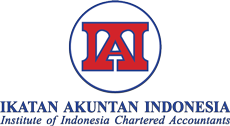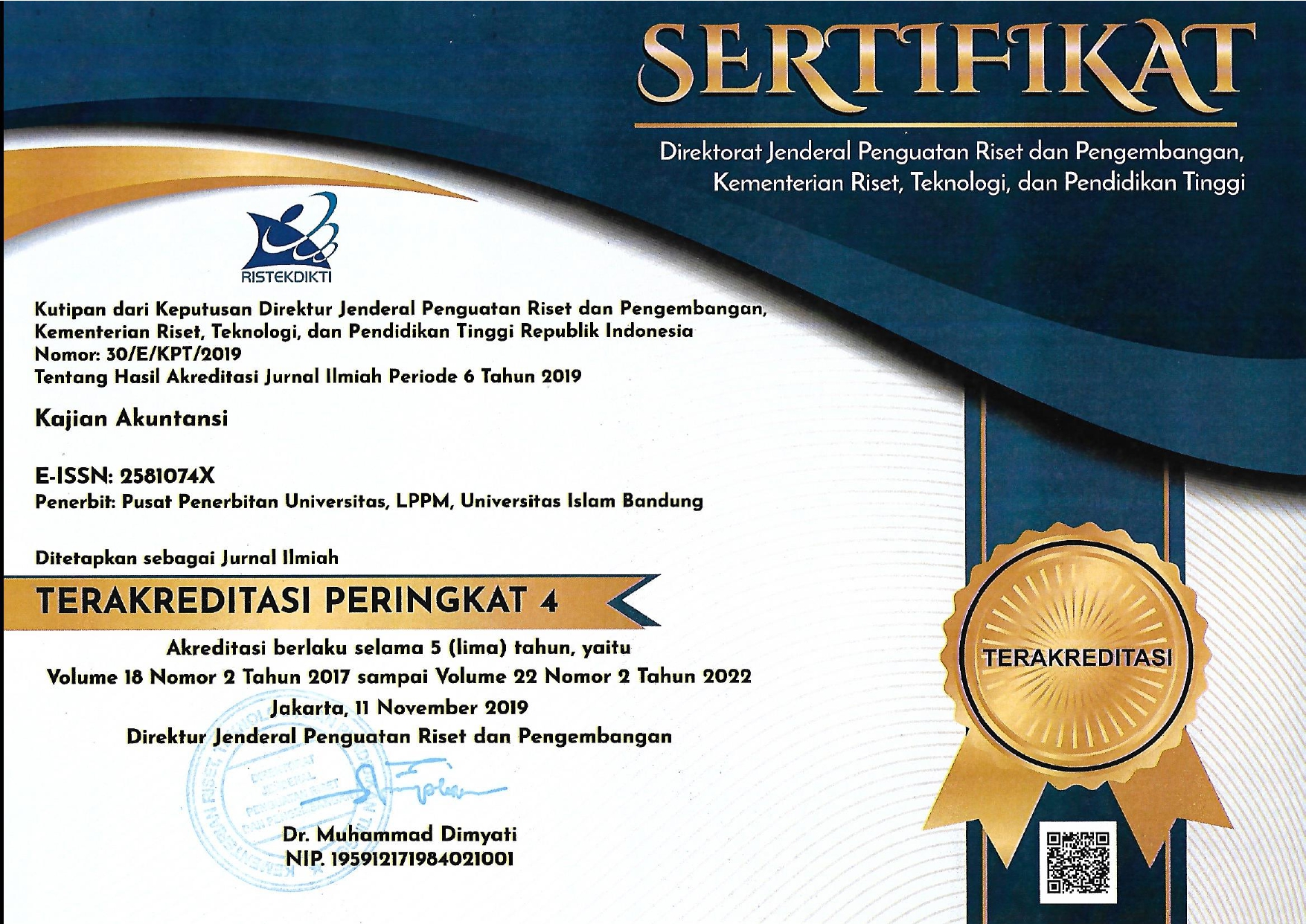Intellectual Capital Performance Of State-Owned Enterprises In Indonesia
Abstract
Tujuan penelitian ini untuk mengukur kinerja pengelolaan modal intelektual di Badan Usaha Milik Negara dengan menggunakan model Pulic dikenal dengan Value Added Intellectual Capital. Data yang digunakan adalah laporan keuangan BUMN tahun 2020. Hasil kajian menunjukkan 10 BUMN dengan kategori top performance dan 11 BUMN dengan kategori bad performance. Implikasi penilaian ini mendorong BUMN untuk terus membenah dalam memanfaatkan modal intelektual untuk menciptakan nilai agar mampu bertahan dan memiliki daya saing di Era Pengetahuan saat ini.
The purpose of this study is to measure the performance of intellectual capital management in State-Owned Enterprises using the Pulic’s model known as Value Added Intellectual Capital. The data used is the financial statements of SOEs for 2020. The results of the study show 10 SOE’s in the top performance category and 11 SOE’s in the bad performance category. The implications of this assessment encourage SOE’s to continue to improve in utilizing intellectual capital to create value in order to be able to survive and have competitiveness in the current Knowledge Age.
Keywords
Full Text:
PDFReferences
Asadi, S. (2013). Intellectual capital knowledge management : organizational value creation. European Online Journal of Natural and Social Scineces, 2(3), 462–476. Retrieved from www.european-science.com%0AAbstract
Freeman, R. E., Harrison, J. S., Wicks, A. C., Parmar, B., & de Colle, S. (2010). Stakeholder theory: The state of the art. In Stakeholder Theory: The State of the Art. https://doi.org/10.1017/CBO9780511815768
García Castro, J. P., Duque Ramírez, D. F., & Moscoso Escobar, J. (2021). The relationship between intellectual capital and financial performance in Colombian listed banking entities. Asia Pacific Management Review, 11(Mei), 1–11. https://doi.org/10.1016/j.apmrv.2021.03.002
Gogan, L. M., Artene, A., Sarca, I., & Draghici, A. (2016). The Impact of Intellectual Capital on Organizational Performance. Procedia - Social and Behavioral Sciences, 221(0), 194–202. https://doi.org/10.1016/j.sbspro.2016.05.106
Gunawan, H., & Ramadhani, W. (2018). How Intellectual Capital Effects Firm’s Financial Performance. Journal of Applied Accounting and Taxation, 3(1), 1–8.
Haris, M., Yao, H., Tariq, G., Malik, A., & Javaid, H. (2019). Intellectual Capital Performance and Profitability of Banks: Evidence from Pakistan. Journal of Risk and Financial Management, 12(2), 56. https://doi.org/10.3390/jrfm12020056
Hejase, H. J., Hejase, A. J., Tabsh, H., & Chalak, H. C. (2016). Intellectual Capital: An Exploratory Study from Lebanon. Open Journal of Business and Management, 04(04), 571–605. https://doi.org/10.4236/ojbm.2016.44061
Islahul amri, & Misbahul Munir. (2020). Peran Moderasi Human Capital Diantara Pengaruh PMA dan PMDN Terhadap Pertumbuhan Ekonomi. Ekspansi: Jurnal Ekonomi, Keuangan, Perbankan Dan Akuntansi, 12(1), 65–76. https://doi.org/10.35313/ekspansi.v12i1.1861
Laoli, N. (2021, September 2). Direktur Utama PLN Zulkifli Zaini buka-bukaan persoalan utang yang membengkak. Kontan.Co.Id.
Li, Y., Song, Y., Wang, J., & Li, C. (2019). Intellectual capital, knowledge sharing, and innovation performance: Evidence from the Chinese Construction Industry. Sustainability (Switzerland), 11(9). https://doi.org/10.3390/su11092713
Marcelia, E., & Purnomo, B. S. (2016). Pengaruh Nilai Tambah Modal Intelektual Dan Pengungkapan Modal Intelektual Terhadap Nilai Perusahaan (Studi Pada Perusahaan Perbankan Yang Terdaftar Di Bursa Efek Indonesia). Jurnal ASET (Akuntansi Riset), 8(1), 29. https://doi.org/10.17509/jaset.v8i1.4019
Nasution, A., & Ovami, D. (2021). Modal Intelektual dan Nilai Perusahaan Asuransi di Indonesia. Kajian Akuntansi, 22(2), 162–174.
Nuryaman, Kartadjumena, E., & Arnan, S. G. (2019). The Influence of Intellectual Capital on Earning Management through Real Activities Manipulation in Indonesian Manufacturing Companies. International Journal of Economics and Business Research, 18(3). https://doi.org/10.1504/IJEBR.2019.102724
Örnek, A. Ş., & Ayas, S. (2015). The Relationship between Intellectual Capital, Innovative Work Behavior and Business Performance Reflection. Procedia - Social and Behavioral Sciences, 195, 1387–1395. https://doi.org/10.1016/j.sbspro.2015.06.433
Pulić, A. (2008). The Principles of Intellectual Capital Efficiency - A Brief Description. In Croatian Intellectual Capital Center.
Situmorang, D. R., & Purba, L. A. (2021). Analisis Informasi Modal Intelektual Terhadap Nilai Perusahaan Pada Perusahaan Consuer Goods Industry yang terdatra di Bursa Efek Indonesia. Jurnal Akuntansi Dan Keuangan Methodist, 4(2), 174–187.
Stewart, T., & Ruckdeschel, C. (2007). Intellectual Capital: The new Wealth of Organizations. USA: Wiley.
Sullivan, P. (2000). Value-Driven Intellectual Capital: How to Convert Intangible Corporate Assets into Market Value. Wiley.
Taufan. (2021, September 20). Gabungan Importir Nasional Seluruh Indonesia Minta Pemerintah Evaluasi Kinerja Krakatau Steel (KS). Kontan.Co.Id.
Ulum, I. (2008). Intellectual Capital Performance Sektor Perbankan di Indonesia. Jurnal Akuntansi Dan Keuangan, 10(2), 77–84. https://doi.org/10.9744/jak.10.2.PP.77-84
Undang-undang Republik Indonesia Nomor 19 Tahun 2003 tentang Badan Usaha Milik Negara.
Wareza, M. (2021). Ya Ampun Garuda Kritis, Defisitnya Kalahkan Jiwasraya! CNBC Indonesia.
Yolandha, F. (2021). Kementerian BUMN akan tutup 7 BUMN Sekarat Tahun ini. Republikas.Co.Id.
DOI: https://doi.org/10.29313/ka.v23i1.9079
Refbacks
- There are currently no refbacks.
Copyright (c) 2022 Kajian Akuntansi
Indexed by:
This work is licensed under a Creative Commons Attribution-NonCommercial-ShareAlike 4.0 International License.










